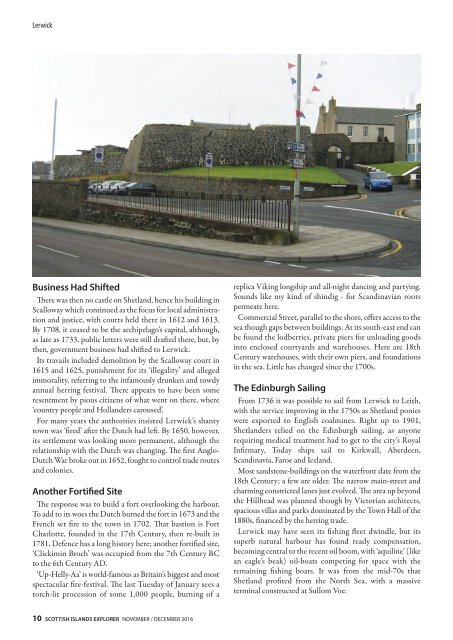You also want an ePaper? Increase the reach of your titles
YUMPU automatically turns print PDFs into web optimized ePapers that Google loves.
Lerwick<br />
Business Had Shifted<br />
ere was then no castle on Shetland, hence his building in<br />
Scalloway which continued as the focus for local administration<br />
and justice, with courts held there in 1612 and 1613.<br />
By 1708, it ceased to be the archipelago’s capital, although,<br />
as late as 1733, public letters were still draed there, but, by<br />
then, government business had shied to Lerwick.<br />
Its travails included demolition by the Scalloway court in<br />
1615 and 1625, punishment for its ‘illegality’ and alleged<br />
immorality, referring to the infamously drunken and rowdy<br />
annual herring festival. ere appears to have been some<br />
resentment by pious citizens of what went on there, where<br />
‘country people and Hollanders caroused’.<br />
For many years the authorities insisted Lerwick’s shanty<br />
town was ‘fired’ aer the Dutch had le. By 1650, however,<br />
its settlement was looking more permanent, although the<br />
relationship with the Dutch was changing. e first Anglo-<br />
Dutch War broke out in 1652, fought to control trade routes<br />
and colonies.<br />
Another Fortified Site<br />
e response was to build a fort overlooking the harbour.<br />
To add to its woes the Dutch burned the fort in 1673 and the<br />
French set fire to the town in 1702. at bastion is Fort<br />
Charlotte, founded in the 17th Century, then re-built in<br />
1781. Defence has a long history here; another fortified site,<br />
‘Clickimin Broch’ was occupied from the 7th Century BC<br />
to the 6th Century AD.<br />
‘Up-Helly-Aa’ is world-famous as Britain’s biggest and most<br />
spectacular fire-festival. e last Tuesday of January sees a<br />
torch-lit procession of some 1,000 people, burning of a<br />
replica Viking longship and all-night dancing and partying.<br />
Sounds like my kind of shindig - for Scandinavian roots<br />
permeate here.<br />
Commercial Street, parallel to the shore, offers access to the<br />
sea though gaps between buildings. At its south-east end can<br />
be found the lodberries, private piers for unloading goods<br />
into enclosed courtyards and warehouses. Here are 18th<br />
Century warehouses, with their own piers, and foundations<br />
in the sea. Little has changed since the 1700s.<br />
The Edinburgh Sailing<br />
From 1736 it was possible to sail from Lerwick to Leith,<br />
with the service improving in the 1750s as Shetland ponies<br />
were exported to English coalmines. Right up to 1901,<br />
Shetlanders relied on the Edinburgh sailing, as anyone<br />
requiring medical treatment had to get to the city’s Royal<br />
Infirmary. Today ships sail to Kirkwall, Aberdeen,<br />
Scandinavia, Faroe and Iceland.<br />
Most sandstone-buildings on the waterfront date from the<br />
18th Century; a few are older. e narrow main-street and<br />
charming constricted lanes just evolved. e area up beyond<br />
the Hillhead was planned though by Victorian architects,<br />
spacious villas and parks dominated by the Town Hall of the<br />
1880s, financed by the herring trade.<br />
Lerwick may have seen its fishing fleet dwindle, but its<br />
superb natural harbour has found ready compensation,<br />
becoming central to the recent oil boom, with ‘aquiline’ (like<br />
an eagle’s beak) oil-boats competing for space with the<br />
remaining fishing boats. It was from the mid-70s that<br />
Shetland profited from the North Sea, with a massive<br />
terminal constructed at Sullom Voe.<br />
10 SCOTTISH ISLANDS EXPLORER NOVEMBER / DECEMBER <strong>2016</strong>















